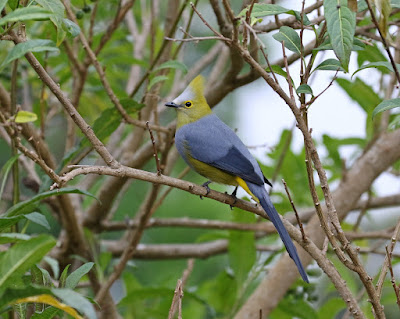Savegre has changed a lot since our visit in 2008. Back then it was called Savegre Mountain
Lodge. Now it’s Savegre Hotel, Natural
Reserve and Spa. There is a lot more
emphasis on it being a spa and having the best cuisine in the region.
The rooms have been remodeled and are very nice.
I’m not sure why we ended up with 3 beds! We also had an electric heater in the room that ran some of the day and all night, as temperatures got down into the upper 30's!
We didn’t have anything scheduled for this afternoon so
after lunch we walked around. To get to
the hotel you cross over this beautiful stream, which is the headwater of the Savegre River.
The birds at Savegre are totally different than the birds found down on the Pacific Coast. Many of them are "endemics" which means that they are found in a very small geographical area. The mountains of Costa Rica and Western Panama have dozens of endemics that exist only in these countries at these high elevations.
The Volcano Hummingbird is one such species. There are three "races", with the males having a different throat color depending on which mountain range they are in. Savegre is in the Talamanca Cordillera, so the Volcano Hummingbirds here have purple gorgets. In other parts of Costa Rica they are red or orange.
Volcano Hummingbird male
The landscaping around the lodge is beautiful. We spent our first afternoon exploring the grounds and enjoying the cool temperatures.
Long-tailed Silky-flycatchers are another high-elevation endemic, and we were pleased to see dozens of them.
Long-tailed Silky-flycatcher
Although things were more developed than they had been 11 years ago, we found plenty of beautiful areas and birds to enjoy. The Yellow-thighed Finch is (yet another) endemic at this location. It looks like an ordinary charcoal-colored bird until you get a look at it's bright yellow thighs! Well named!
Yellow-thighed Finch
A very common bird in the gardens was the Lesser Violetear, a type of hummingbird. These birds range all of the way down into South America, and the closely related Green Violetear is found to the north as far as south Texas.
They have the ability to "flare" their ears out in a territorial display.
They have the ability to "flare" their ears out in a territorial display.
Lesser Violetear
Next: An early date with a special bird.












Some beautiful birds in this one! Wonder if I keep looking at your pictures if I'll catch birding?
ReplyDeleteIf you catch it, there is no cure...
DeleteWhat a diverse place Costa Rica must be. We need to add it to our wish list.
ReplyDeleteGreat pictures.
It is a remarkable amount of terrain and ecology packed into a very small place!
DeleteLoved the violetear. You can really see why it is named that.
ReplyDelete